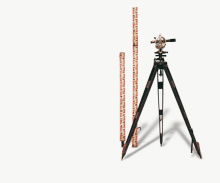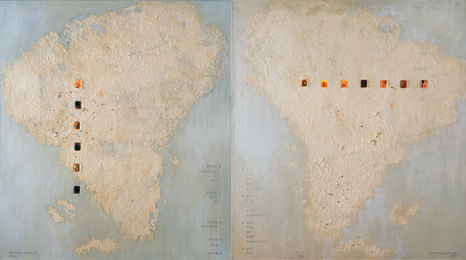Cartografías y Memoria
Cartographies and memory
MEMORIA DESDE ADENTRO
MEMORY FROM WITHIN
— desde 2002 / since 2002
El carácter sagrado de la naturaleza se me presentó siempre con fuerza y asimismo la preocupación por el cuidado de la misma. Me identifico en sus semillas, en sus frutos, en la cicatriz de sus piedras. Pienso entonces que mi obra va y vuelve desde la tierra donde habito hasta un imaginario universal. El hallazgo de un caracol fósil, un amonita, en la Patagonia, me provocó un interés particular. Reflexioné sobre el desarrollo del mismo, que se realiza según las medidas consideradas sagradas, la “divina proporción”, imagen del laberinto desarrollado por el hombre de todos los tiempos (en el piso de catedrales góticas, en el imaginario borgiano, en jardines barrocos). Tomé fotografías y registré las rugosidades de su superficie con papel hecho a mano. Apoyé en él mi itinerario y en una serie de cartografías de América, procurando quedar atenta a este lugar geográfico, mi continente.
The sacred character of Nature has always appeared before me with strength, and so has concern for its care. I find myself in its seeds, in its fruits, in the scarred surface of its rocks. I therefore think that my creation goes and comes back from the Earth that I inhabit up to an universal imaginary. The finding of a fossil shell, an ammonite, in Patagonia, arose in me a particular interest. I reflected on its development, that takes place according to the measurements considered sacred, the ”divine proportion”, image of the maze developed by men of all times ( on the floor of Gothic cathedrals, in the Borgian imaginary, in Baroque gardens) I took photos and recorded the rough quality of its surface with handmade paper. I lay my itinerary on it and on a series of cartographies of America, trying to be aware of this geographical site, my continent.
EP


Dos Américas (Díptico)
óleo, papel h. a mano, resina, semillas y luz interior s.tela, 100 x 200 cm.
Colección Museo Sívori























Albino Diéguez Videla,
editor de cultura del diario La Prensa.
editor of culture of La Prensa newspaper
— La Prensa 20 / 06 / 2004
Huellas de tiempos remotos y recuerdos familiares se entremezclan. Naturaleza e historia conforman un orden que Pereda interroga a partir de un fósil hallado en la Patagonia, recobra la armonía original y la estructura espiralada del caracol Nautilus, testimonia que en la estepa árida existió un mar perdido milenios atrás. Para interrogar el origen de la creación, Pereda echa mano al pensamiento científico, la antropología, la historia, la condición de la mujer y la religiosidad.
Traces of times gone by and family memories are interweaved. Nature and history conform an order which Pereda questions from a fossil found in Patagonia, recovers the original harmony and the spiral structure of a Nautilus shell, testifies that in the infertile plateau there existed an ocean lost millenniums ago. To question the origin of Creation, Pereda resorts to scientific thinking, anthropology, history, the condition of woman and religiousness.























